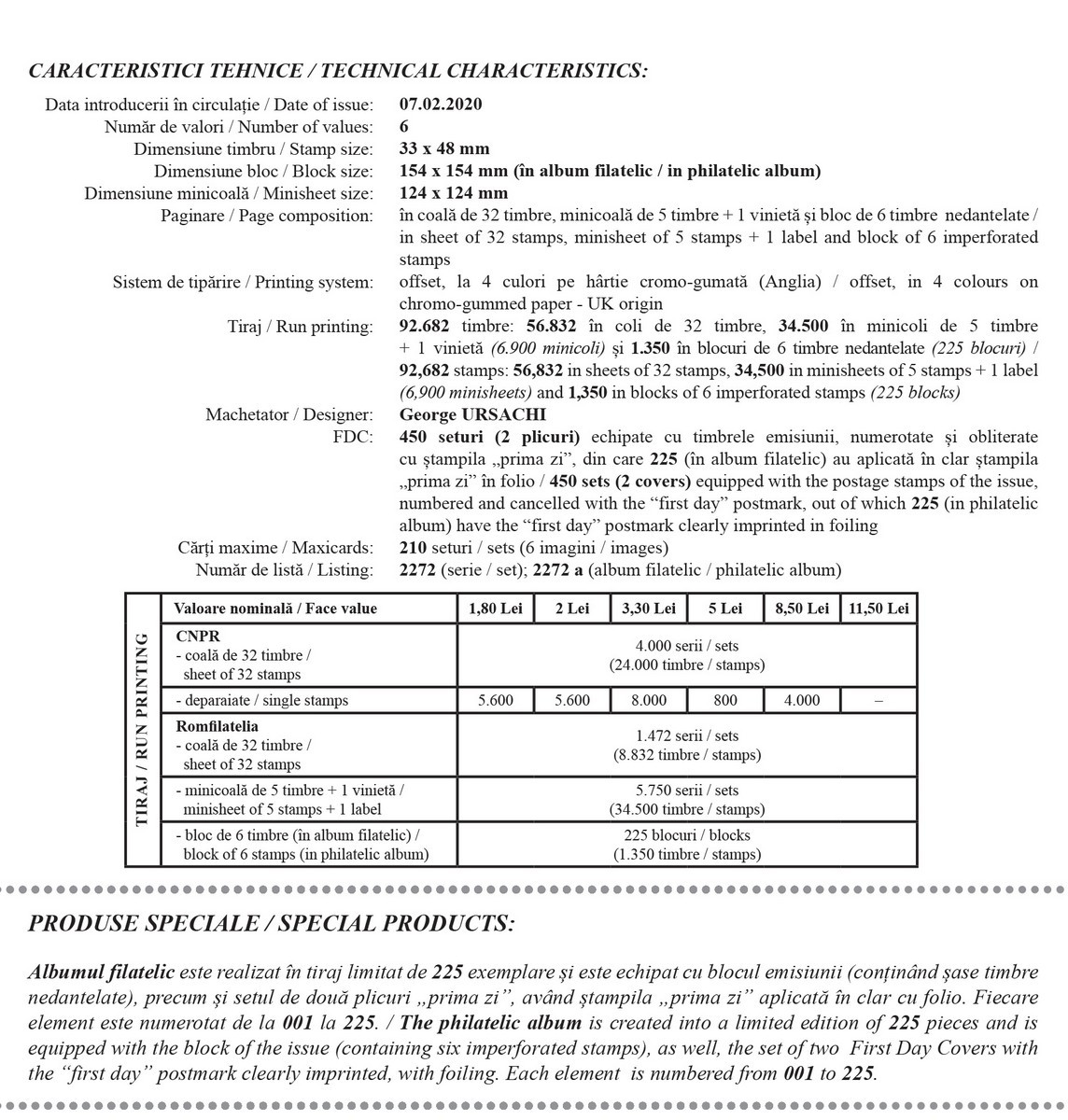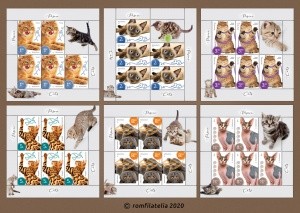Romfilatelia introduces into circulation on Friday, February 7th, current year, the postage stamps issue Cats, an occasion for joy for both pet lovers and philatelists.
The domestic cat (Felis catus) is a small carnivorous mammal. It is the only domesticated species in the Felidae family. Cats can be of three types: domestic cat, farm cat or wild cat. Unlike wild cats that live in freedom and avoid contact with humans, the domestic cat is around humans and limits their hunting instinct to species such as rodents and small birds in their surrounding area.
Anatomically similar to the other species of Felidae, the domestic cat has fast reflexes, sharp teeth, a strong flexible body and retractable claws adapted for small prey. The well-developed sense of smell and night vision ensure a real advantage in hunting. Although it is a sociable species, the domestic cat hunts alone.
Cats’ way of communicating includes vocalizations such as meowing, trilling, purring, growling, hissing, grunting, and body language specific to cats. They hear sounds with frequencies too low and too high for human ears. As a prey animal, the domestic cat’s activity is most dynamic at dusk and dawn.
The Persian cat, found on the postage stamp with the face value of Lei 1.80, is a breed with long fur, characterized by its round face, wide head with ears positioned far apart, big eyes, extremely short muzzle and the short legs. In the Middle East it is known as the Iranian cat or the Shiraz cat. These specimens may have any combination of colors or markings on the fur. The Persian cat is generally described as a quiet cat, with a peaceful temperament.
The Siamese cat is portrayed on the postage stamp with the face value of Lei 2. This is one of the most distinctive breeds of Asian cat. The modern Siamese is noted by its cylindrical, elongated and muscular body as well as its triangular head which forms a perfect triangle from the tip of the nose to the tips of the ears. The eyes are almond shaped, blue and the ears are large, wide at the base and positioned towards the sides of the head.
This breed has an elongated neck, narrow tail and a fine, glossy fur that adheres to the body. Siamese cats are intelligent, sociable, affective and playful since they are kittens and remain so at maturity. They feel the need to interact with people and seek the company of other cats.
The British shorthair, found on the postage stamp with the face value of Lei 3.30, is a British traditional breed. It is recognizable through its dense fur, thick body, and wide face. This is a breed with strong features, wide chest, thick and strong legs, rounded paws and a medium-sized tail. The head is relatively large and rounded with a short muzzle, wide cheeks and large round eyes. The ears are wide and far apart. The most common color in this race is British blue, rendered on the postage stamp with the face value of Lei 8.50, which is noticeable by the monochrome, gray fur, with blue tints and orange eyes. British shorthair fur is one of the defining traits of the breed. The coat is very dense but has no undercoat and therefore has a fluffy and not woolly texture.
The Bengal cat, illustrated on the postage stamp with the face value of Lei 5, created by pairing domestic cat hybrids with the Asian leopard cat (Prionailurus bengalensis) and the Egyptian Mau, which give them a golden glow to the fur. One of the most distinctive features of this feline is its unique fur pattern and colouring. These cats have a wild appearance and their fur can present with spots, rosettes, arrows or a marble pattern. Bengal cats have an athletic appearance, with well-defined muscles, creating a sombre and balanced appearance. They have high cheekbones, dark contours around the eyes and the ears are small and sharp around the tips.
The Sphinx cat, known for its lack of fur, is shown on the postage stamp with a face value of Lei 11.50. The lack of fur is a genetic mutation of natural origin although this particular breed was obtained through selective breeding. They have a long and narrow head and the skin exhibits the colour that their coat should have had and therefore it can have a stained, tarred, striped or diffused colouring in strategic points of the body. The toes of the paws are connected by a membrane and due to the lack of fur, they lose body temperature faster than other cats, forcing them to look for other heat sources.
Romfilatelia thanks the “Grigore Antipa” National Museum of Natural History from Bucharest for the documentary support granted to the achievement of this postage stamps issue.



